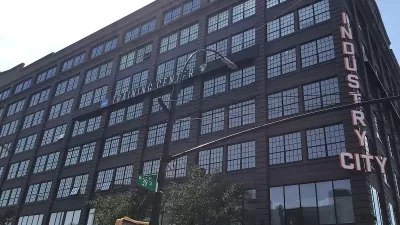“Underpriced land and room for upward growth in rents is the magic formula that developers seek in the next hot neighborhood.” Just to the east of prospect Park in Brooklyn is a place that has both.
Alison Gregor writes a long article on the changes on coming to the Brooklyn neighborhood of Prospect-Lefferts Gardens, described by some as “Brooklyn’s best-kept secret”—at least until now.
So what does it take for a neighborhood in to gain “it” status in New York City’s famous real estate market? The list for Prospect-Lefferts Gardens reads the like the crown jewels of urbanism: “bordering the east side of Prospect Park and down the road from the Brooklyn Botanic Garden, with a substantial and attractive historic district, and subway stops for three express trains.”
Not to mention that “[it’s] also a community with no hard-and-fast height limits on development, and its real estate can cost as little as half that on the other side of the park.”
Those conditions are attracting a lot of attention from developers: “There are about 10 projects in the works to create luxury rentals or condominiums in the neighborhood…” But those changes are a rude awakening for the 40,000 long-time resident of the neighborhood—African-American and Caribbean-American—who haven’t seen much change in the neighborhood. How completely has the neighborhood been able to slip under the development radar? It’s last significant development investment came in the 1960s: “The last substantial development in Prospect-Lefferts Gardens was Patio Gardens, two 16-story towers with about 460 apartments at 580-590 Flatbush, which went up in the early 1960s, before the neighborhood received its current name.”
Reactions of residents include a call for a moratorium on certain high-rise development until zoning can be changed and a lawsuit to stop a project at 626 Flatbush Avenue, a block from Prospect Park.
FULL STORY: Prospect-Lefferts Gardens Is ‘On the Map’

Alabama: Trump Terminates Settlements for Black Communities Harmed By Raw Sewage
Trump deemed the landmark civil rights agreement “illegal DEI and environmental justice policy.”

Planetizen Federal Action Tracker
A weekly monitor of how Trump’s orders and actions are impacting planners and planning in America.

The 120 Year Old Tiny Home Villages That Sheltered San Francisco’s Earthquake Refugees
More than a century ago, San Francisco mobilized to house thousands of residents displaced by the 1906 earthquake. Could their strategy offer a model for the present?

In Both Crashes and Crime, Public Transportation is Far Safer than Driving
Contrary to popular assumptions, public transportation has far lower crash and crime rates than automobile travel. For safer communities, improve and encourage transit travel.

Report: Zoning Reforms Should Complement Nashville’s Ambitious Transit Plan
Without reform, restrictive zoning codes will limit the impact of the city’s planned transit expansion and could exclude some of the residents who depend on transit the most.

Judge Orders Release of Frozen IRA, IIJA Funding
The decision is a victory for environmental groups who charged that freezing funds for critical infrastructure and disaster response programs caused “real and irreparable harm” to communities.
Urban Design for Planners 1: Software Tools
This six-course series explores essential urban design concepts using open source software and equips planners with the tools they need to participate fully in the urban design process.
Planning for Universal Design
Learn the tools for implementing Universal Design in planning regulations.
Clanton & Associates, Inc.
Jessamine County Fiscal Court
Institute for Housing and Urban Development Studies (IHS)
City of Grandview
Harvard GSD Executive Education
Toledo-Lucas County Plan Commissions
Salt Lake City
NYU Wagner Graduate School of Public Service





























